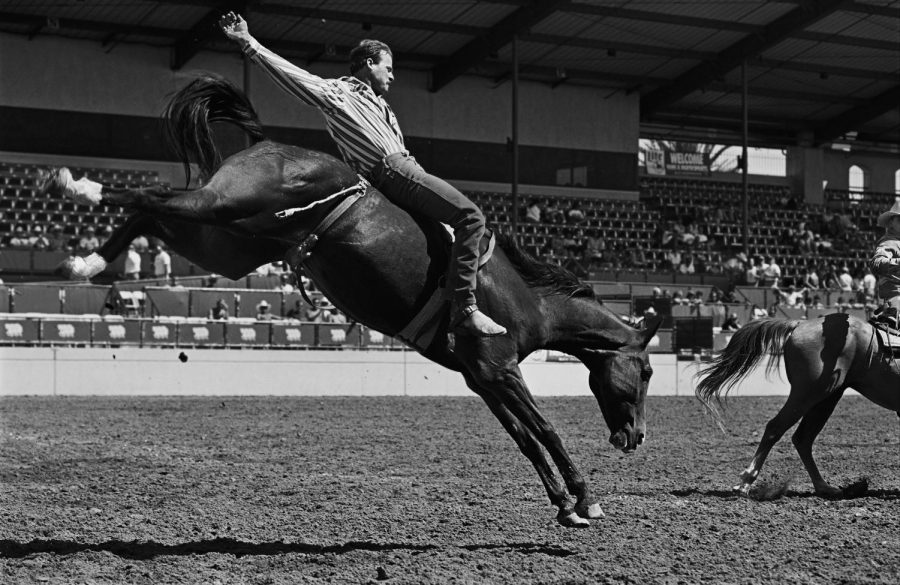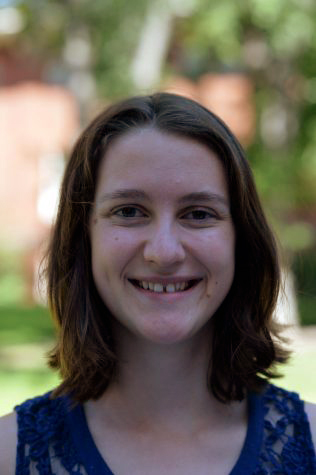‘Photographs from the Gay Rodeo’ showing at UI
University of Idaho library hosts photo exhibit; Blake Little chronicles gay rodeo in Western history
COURTESY OF DULCE KERSTING-LARK
Blake Little’s photographs, including “Bareback Bronc Riding,” pictured above, are being shown in the exhibit at the University of Idaho library through April 30. Little’s black and white portraits feature LGBTQ riders on the rodeo circuit.
February 7, 2019
With an opening reception Tuesday evening, Seattle-born photographer Blake Little’s “Photographs from the Gay Rodeo” exhibit kicked off at the University of Idaho Library, to be continued through April 30.
The rodeo is a series of events across the country headed by the International Gay Rodeo Association. The events, according to the association’s website, are intended to “[promote], in a positive way, the LGBTQ country western lifestyle” and “[support] amateur sportsmanship,” among other related goals.
Rebecca Scofield, University of Idaho assistant professor of 20th century American history, presented on the topic in January, which was part of the reason why the Latah County Historical Society chose to feature the exhibit.
Dulce Kersting-Lark, Latah County Historical Society executive director, said the Eiteljorg Museum of American Indians and Western Art, where the exhibit was originally curated, had a short-notice break in the exhibit’s touring schedule. Her own research as a historian dealt with the American West, and she said the ties with Scofield aided in her choice to rent the exhibit.
“Rodeo is a performance in Western expansion,” Kersting-Lark said. “This exhibit adds nuance to … perceived stereotypes.”
Little’s work consists of 41 photos depicting gay rodeos, its participants and the culture around the events, according to the UI Library website.
The series covers rodeos, primarily black and white portraiture, between 1988 and 1992.
Ashlyn Velte, head of special collections for the library, said Kersting-Lark approached her in November about hosting the collection. She said the collaboration achieves university goals of community outreach and diversifying what visitors learn about Western history.
“It’s a really, really beautiful example of photography … they document the experiences of people,” she said. “They’re really moving pieces.”
Velte said the photographs also engage visitors by giving them the experience of a national exhibit on a local level. Because the library’s collecting area often includes American West topics like mining, agriculture and environmental history, Little’s work fits in.
She said the exhibit asks questions about identity and perceptions, as well as prompting the viewer to question their own expectations about rodeo and the West.
“It documents a portion of Western culture which, historically, has not been talked about,” Velte said.
Kersting-Lark said the exhibit’s closing reception will feature Scofield and her research. There will also be a free showing of the documentary “Queens and Cowboys: A Straight Year on the Gay Rodeo” at 7 p.m. March 6 at the Kenworthy Performing Arts Centre.











Heather • Feb 7, 2019 at 9:17 pm
Anna, PLEASE stop glorifying violence against sentient, innocent creatures. Rodeo is disgustingly cruel, whether it is a breeder or straight rodeo. As a straight woman with a huge circle of gay friends, I have to say that I am even more offended with this. All of the gay men I know are sincere, loving, kind, genuine. And they would never deliberately harm another creature. There is nothing to be proud of here, boys. You are just as gross and hideous as the breeder cowboys when you commit these atrocities. REAL MEN ARE KIND, whether gay or straight. PLEASE find something else to do, that does not involve harming others. As a population that has been oppressed and that has had to fight for its rights for so long- why would you stifle the rights and the liberties of others?! Think about what you are doing! You would NOT want this done to you!
Animal Compassion • Feb 7, 2019 at 2:42 pm
Perhaps we should leave the animals alone now . . . and find another way to be competitive, have fun, be outdoors, etc ~
Annoula Wylderich • Feb 7, 2019 at 2:06 pm
Unfortunately, there’s nothing gay about abusing terrified animals! Time after time, there have been injuries and deaths exposed relating to these events. The animals are not participating willingly and those who are practiced upon might suffer the worst, but the public won’t see or know about them.
I hope in today’s more civilized society, we can finally begin to understand the impact upon innocent animals who are exploited for entertainment or monetary gain. . .and show them some compassion.
Eric Mills, coordinator, ACTION FOR ANIMALS, Oakland • Feb 7, 2019 at 1:40 pm
Both sad and ironic. As a gay man and long-time critic of rodeos, I am astounded that gay people, in light of our own long history of abuse and disenfranchisement, could take part in rodeos. Does not compute. Rodeos are condemned by nearly EVERY major animal welfare organization in the country, due to their inherent cruelty.
Rodeo has almost NOTHING to do with life on a working ranch. It’s mostly hype. REAL cowboys never routinely rode bulls, or wrestled steers, or rode bareback, or practiced calf roping as a timed event. And they certainly didn’t put flank straps on the horses and bulls (outlawed in Pittsburgh, PA). Rodeo is a macho (and often sexist) exercise in DOMINATION. For nearly all the unwilling animals involved, rodeo is simply a detour en route to the slaughterhouse. And gay people–of all people–should know (and do) better. Surely there are more compassionate, life-affirming activities than this. Even Cesar Chavez was an outspoken critic.
A favored quote: “The eighteen-year-old rodeo queen and her princess told me that rodeo people, including themselves, ‘hated Democrats, environmentalists, and gays.’ I was astonished that their political and social outlook could be reduced to such simple platitudes of hate. And why?” (–from “Rodeo Queens and the American Dream,” by Prof. Joan Burbick, Public Affairs, NYC, 2002)
Rodeos of every stripe–straight, gay, black, police, military, Little Britches, et al.–should be outlawed worldwide, and legislation is in order every year, in every state and province. Until that happy day, BOYCOTT ALL RODEOS AND THEIR CORPORATE SPONSORS AND ADVERTISERS. Follow the money.
Sincerely,
Eric Mills, coordinator
ACTION FOR ANIMALS
Oakland